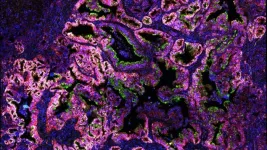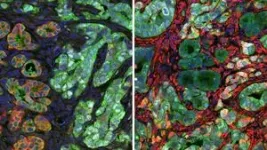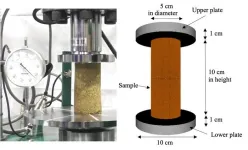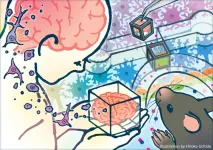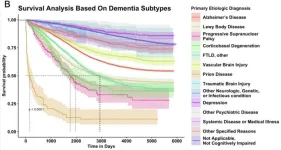(Press-News.org) Knowing exactly what’s inside a tumor can maximize our ability to fight cancer. But that knowledge doesn’t come easy. Tumors are clusters of constantly changing cancer cells. Some become common cancer variants. Others morph into deadlier, drug-resistant varieties. No one truly understands what governs this chaotic behavior.
Now, Cold Spring Harbor Laboratory (CSHL) Professor David Tuveson and his team have uncovered a mechanism involved in pancreatic cancer transformation—mucus. During the disease’s early stage, pancreatic cancer cells produce mucus. Additionally, these cells depend on the body’s regulators of mucus production. This new knowledge could help set the stage for future diagnostic or therapeutic strategies.
The unpredictable, shifting nature of tumors makes it challenging to pinpoint the right treatments for patients. “We need to better understand this concept of cell plasticity and design therapy that takes this into consideration,” says Claudia Tonelli, a research investigator in the Tuveson lab, who led the study.
To find out what’s behind tumors’ erratic behavior, Tonelli teamed with Jonathan Preall from CSHL’s Single-Cell Biology Facility. Together, the scientists broke down messy clumps of pancreatic tumors into individual cancer cells. From there, they could examine the unique differences between each pancreatic cancer type. And that’s where mucus’ role in cancer differentiation oozed into view.
Making mucus is messy and challenging for cancer cells. It takes a lot of resources to assemble and export these protein blobs. So why do it in the first place? The scientists discovered that low-grade pancreatic cancer cells of a common variety, known as the classical type, depend on mucus to survive and thrive. As the cancer cells mature and transform into the deadlier type, known as basal-like, they seem to grow out of this dependency. Tonelli suspects mucus may provide fledgling cancer cells with protection against the immune system.
While therapeutically targeting mucus in young, vulnerable pancreatic cancer cells may have some advantages, it’s a double-edged sword. When mucus production is blocked, cancer cells stop growing. But this forces some of them to become the deadlier basal-like cancer cells as a survival mechanism.
“We would have to do further studies to be ready to hit the cancers once they have undergone this differentiation,” says Tonelli. “Identifying a combination of therapies may be an option.”
Knowing what makes pancreatic cancer cells transform may someday help researchers discover better therapeutics. So, while mucus might not be the key to cracking pancreatic cancer, the answer might yet be found right under our nose.
END
Pancreatic cancer lives on mucus
2024-02-28
ELSE PRESS RELEASES FROM THIS DATE:
Want fewer microplastics in your tap water? Try boiling it first
2024-02-28
Nano- and microplastics are seemingly everywhere — water, soil and the air. While many creative strategies have been attempted to get rid of these plastic bits, one unexpectedly effective solution for cleaning up drinking water, specifically, might be as simple as brewing a cup of tea or coffee. As reported in ACS’ Environmental Science & Technology Letters, boiling and filtering calcium-containing tap water could help remove nearly 90% of the nano- and microplastics present.
Contamination of water supplies with nano- and microplastics (NMPs), which can be as small as one thousandth of a millimeter ...
AGA announces 12-point plan to improve the care of all patients with inflammatory bowel disease (IBD)
2024-02-28
Bethesda, MD (Feb. 28, 2024) — Today, the American Gastroenterological Association (AGA) published a white paper on the future of inflammatory bowel disease (IBD) care in the United States. AGA highlights the current barriers to care and calls for collaboration among our healthcare community, insurers, pharmaceutical companies and legislators to improve and optimize care for the more than three million Americans living with IBD.
IBD is a complex disease that requires a vigilant and coordinated multidisciplinary approach. ...
Shedding light on the intricacies of numerical simulations of soil behavior
2024-02-28
A solid understanding of soil mechanics and behavior is one of the fundamental pillars of geotechnical engineering. The stability and resilience of many modern geotechnical structures, including building foundations, dams, bridges, and embankments, rely on appropriate modelling based on accurate measurements of soil properties.
Over the past few decades, unprecedented growth in computing power has turned numerical simulations of soil behavior into an attractive tool in geotechnical engineering. By representing soil as a set of interacting particles, numerical simulations can help researchers understand complex soil behavior under various conditions. Moreover, numerical ...
Promising pathways to simplified Alzheimer's diagnosis unveiled in groundbreaking study
2024-02-28
Washington D.C., Feb. 28, 2024- The Global Alzheimer’s Platform Foundation®, (GAP) is releasing the first results from the Bio-Hermes-001 Study. This study in over 1000 community-based participants from throughout the US compared the results of blood and digital biomarkers with brain amyloid PET scans or cerebrospinal fluid assays. The study revealed a strong correlation between several blood tests, particularly p-tau 217, with the presence of amyloid plaques in the brain, a diagnostic hallmark of Alzheimer’s disease (AD). This relationship was demonstrated across the entire study ...
Understanding genetic risk could save sight and predict multiple sclerosis earlier in young people
2024-02-28
Young people could be spared from going blind by a new genetic risk tool that could also help diagnose multiple sclerosis (MS) earlier, to start effective treatments.
Optic neuritis is a condition that affects people of all ages, but especially young adults, usually manifesting in blurred vision and sometimes pain when moving the eyes. Up to half of people affected in the UK eventually go on to develop MS – often many years later. Emerging evidence indicates that starting the very effective MS treatments earlier may improve long term health.
Optic neuritis occurs because of swelling in or around the optic nerve. For those with MS-related optic neuritis, the swelling subsides ...
Cannabis use linked to increase in heart attack and stroke risk
2024-02-28
Research Highlights:
An analysis of survey data for 430,000 adults in the U.S. found that using cannabis has a significant association with an increased risk of heart attack and stroke, independent of tobacco use, with higher odds among the adults with more frequent use (more days of use per month). The most common method of cannabis use was smoking, followed by eating or vaporizing it.
The increase in the combined risk of coronary heart disease, heart attack and stroke was similar to the risk among the subset of adults who had never used e-cigarettes but did use cannabis.
Embargoed until 4 a.m. CT/5 a.m. ET Wednesday, February ...
Researchers model blood-brain barrier using “Tissue-in-a-CUBE" system
2024-02-28
A research team at the RIKEN Center for Biosystems Dynamics Research (BDR) in Japan has succeeded in establishing a model of the blood-brain barrier using modularized tissue derived from human cells. The “Tissue-in-a-CUBE” is a small cubic structure that could provide a boost in the drug discovery field and be used as an alternative to animal models in pre-clinical studies. The study was published in Communications Biology on February 28.
The blood-brain barrier is a strict gatekeeper around the brain that prevents foreign substances in blood from entering the brain. Although protective, the barrier poses challenges when treatments ...
Study identifies blood biomarkers to predict risk of cardiovascular disease in patients with rheumatoid arthritis
2024-02-28
KEY TAKEAWAYS
Rheumatoid arthritis is associated with increased risk of cardiovascular disease, but it can be challenging to predict which individuals are at highest risk.
Mass General Brigham experts in rheumatology and cardiovascular disease worked together to identify six biomarkers found in blood samples that can predict future risk of arterial inflammation among patients with rheumatoid arthritis.
The team is now working to test these biomarkers in a larger and more long-term cohort of patients with rheumatoid ...
Ai finds key signs that predict patient survival across dementia types
2024-02-28
New York, NY [February 28, 2024]—Researchers at the Icahn School of Medicine at Mount Sinai and others have harnessed the power of machine learning to identify key predictors of mortality in dementia patients.
The study, published in the February 28 online issue of Communications Medicine [10.1038/s43856-024-00437-7], addresses critical challenges in dementia care by pinpointing patients at high risk of near-term death and uncovers the factors that drive this risk. Unlike previous studies that focused on diagnosing dementia, this research delves into predicting patient prognosis, shedding light on mortality ...
Light stimulates a new twist for synthetic chemistry
2024-02-28
Molecules that are induced by light to rotate bulky groups around central bonds could be developed into photo-activated bioactive systems, molecular switches, and more.
Researchers at Hokkaido University, led by Assistant Professor Akira Katsuyama and Professor Satoshi Ichikawa at the Faculty of Pharmaceutical Sciences, have extended the toolkit of synthetic chemistry by making a new category of molecules that can be induced to undergo an internal rotation on interaction with light. Similar processes are believed to be important in some natural biological systems. Synthetic versions might ...
